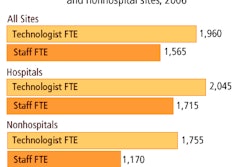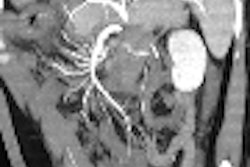CHICAGO - Virtual colonoscopy without cathartic bowel cleansing is an important potential solution to low colorectal cancer screening compliance. Studies suggest that patients would be more willing to undergo screening if they could skip the uncomfortable laxative regimen that is required for both optical and virtual colonoscopy.
Toward this end, increasingly sophisticated electronic cleansing schemes are being developed to digitally subtract residual stool from CT data, but testing has been limited to small experimental studies, and performance of these applications in the clinical setting is not well understood.
A clinical study presented Monday at the 2006 RSNA meeting found that electronic stool subtraction helped radiologists find more medium-sized polyps, although it also added a few false positives and reduced specificity.
Dr. C. Daniel Johnson from the Mayo Clinic in Rochester, MN, presented a study that examined 114 patients with known or suspected colorectal polyps or cancer.
The patients (76% men, average age 65 years) underwent prepless virtual colonoscopy, followed the next day by optical colonoscopy, which served as the reference standard. The VC findings were read twice, both without stool subtraction and in a combined reading showing the CT images with and without stool subtraction.
Various processing techniques were used to identify and subtract the stool in a process described by Dr. Michael Carston et al ("CT colonography of the unprepared colon: An evaluation of electronic stool subtraction," Proceedings of SPIE - Medical Imaging 2005: Physiology, Function, and Structure from Medical Images, Vol. 5746, p. 424-431).
Johnson's co-investigators in the prepless VC study at Mayo were Armando Manduca, Ph.D.; Michael Carston; Dr. Joel Fletcher; Dr. Robert MacCarty; and Lynn Wilson.
Before the exams, all patients ingested 20 grams of oral barium sulfate capsules at meals over 48 hours before VC, without any dietary restrictions. The colon was insufflated with carbon dioxide, and the patients were scanned in both supine and prone positions, Johnson said.
Multidetector-row CT (MDCT) included 8 x 1.25-mm collimation with 1.25-mm reconstruction intervals, 50 mAs, 120 kVp, 0.5-second rotation time, and 1.35 pitch. Two of three VC-experienced radiologists working independently read each exam twice, using both subtracted and combined (unsubtracted and stool subtracted) datasets. The readers were blinded to findings at colonoscopy and the other radiologist interpretations, and used a primary 2D interpretation method.
"There were 183 polyps in 114 patients, 156 were adenomas, and there were 87 that were 1 cm or larger in size," Johnson said. "For large lesions, there was a fairly left-sided distribution … as well as fairly uniform distribution for medium-sized polyps."
The sensitivity and specificity for adenomas 1 cm and larger was 89%, 85% and 81%, and 88%, 88%, and 100% for readers 1, 2, and 3, respectively. The area under the ROC curve for patients with at least one large adenoma for readers 1, 2, and 3 was 0.94, 0.91, and 0.97 for the unsubtracted CT datasets, and 0.90, 0.90, and 0.95 for combined (subtracted and unsubtracted) readings, respectively (p > 0.05 for each reader).
Most polyps 1 cm and larger were fairly easy to see without the aid of stool subtraction, Johnson said, so the addition of combined reading with stool subtraction did not significantly improve sensitivity; and for these polyps "there was no significant difference between those read without stool subtraction compared to those with subtraction," he said.
However, double reading with electronic cleansing was effective for the underperforming readers. "A drill down of this data shows that the sensitivity without stool subtraction for the three readers varied between 84% and 93%," Johnson said. "Reader 2 actually benefited the most from electronic stool subtraction, picking up five additional patients…. Specificity varied between 94% and 100%; you can see that stool subtraction caused a total of four false positives, and caused specificity to decrease to about 89% for these large lesions."
Predictably sensitivity was lower for intermediate-sized lesions (7-10 mm). The area under the ROC curve ranged from 0.75 to 0.90, Johnson said. Double reading with stool subtraction improved the performance, but the difference was not significant, he said.
Detection of the medium-sized lesions ranged from 53% to 88%, and eight additional patients were detected with the use of stool subtraction, Johnson said. "Specificity (without stool subtraction) ranged from 84% to 95%, but 15 patients had false-positive detections due to stool subtraction, which reduced specificity to about 77%.
"Adenomas greater than 5 mm can be detected in the noncathartic colon," he concluded. "Electronic subtraction is not required, but certainly assists some readers. Stool subtraction seems to be of greatest value for intermediate-sized polyps at least 7 mm in diameter, but at a cost of lower specificity."
Further development of prepless VC with electronic stool subtraction is warranted, he said, and should be extended to an average-risk screening population.
By Eric Barnes
AuntMinnie.com staff writer
November 28, 2006
Related Reading
Advanced electronic cleansing preserves soft tissues in VC, October 11, 2006
New method corrects for hyperattenuation surrounding tagged VC data, August 8, 2006
Window levels matter when viewing submerged polyps in VC, July 24, 2006
Best preps are tailored to VC reading method, November 16, 2005
Copyright © 2006 AuntMinnie.com



















